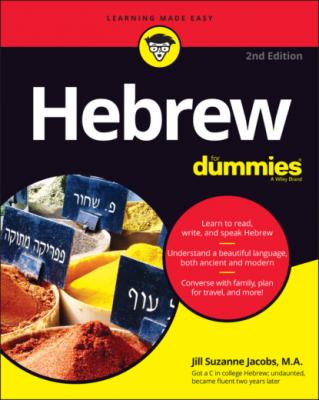Hebrew For Dummies. Jill Suzanne Jacobs
Читать онлайн.| Название | Hebrew For Dummies |
|---|---|
| Автор произведения | Jill Suzanne Jacobs |
| Жанр | Иностранные языки |
| Серия | |
| Издательство | Иностранные языки |
| Год выпуска | 0 |
| isbn | 9781119862048 |
Those dots and dashes they call vowels
Originally, Hebrew had no vowels. Vowels, in the form of dots and lines below the consonants, were added to Hebrew writing in the seventh century CE. Before then, people read without vowels. Even today, most books, magazines, and newspapers in Modern Hebrew — not to mention the Torah scroll — are written without vowels.
Modern Hebrew has both long and short vowels. As a general rule, a long vowel can make up one syllable, but a short vowel needs either another vowel or a שָׁוְא (shuh-vah; two vertical dots below a consonant) to form a syllable. For more on the שָׁוְא, see “Introducing the Shvah” later in this chapter.
As I mentioned earlier, vowels are divided into long and short vowels. This categorization doesn’t have to do with their pronunciation but with the fact that long vowels are usually in open syllables — syllables that end with a vowel — and short vowels are usually in closed syllables — syllables that end with a consonant. The long vowel חִירִיק מָלֵא (Chirik Maleh), however, holds its sound longer than the corresponding short vowel חָרִיק חַסֵּר (hirek haser). Table 1-6 shows the long vowels.
TABLE 1-6 The Long Vowels
| Name of the Vowel | Pronunciation | In Hebrew | The Sound It Makes |
|---|---|---|---|
| Hirik Maleh | ḥee-reek mah-leh | iאִי | Makes an Ee sound as in see |
| Holam | ḥoh-lahm | אֹ |
Makes an O sound as in more
|
